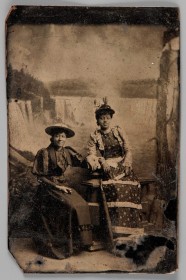A treasure trove in a steamer trunk

Think about your own closets, basements or attics – and how they tend to become storage space for possessions that are no longer useful or relevant to our daily lives.
Now imagine the surprise, joy and wonder that Rick Bell felt when he ventured into his mother’s attic and found an old steamer trunk that just so happened to hold a “treasure trove” of photographs on old tintypes, cabinet cards and cartes-des-visites (a popular, small and relatively cheap form of photograph printed on thick paper cards) from the 1800s. Though they’re far from the kind of photos we’re used to capturing today, their relevance could not be more crucial to Canada at this moment in history, as we contemplate who we are, where we’ve come from and where we’re going.
These rarely seen photographs of men, women and children living in Ontario in the mid-to-late 1800s, many of whom were descendants of Black refugees who escaped enslavement in the southern United States, tell the story of how Black Canadian communities used photography as a tool to visualize and lay claim to their complex histories.
The AGO is proud to showcase these photos, curated from the collection at Brock University (where Rick Bell and his family donated their discovered collection of photographs) and from the Ontario Archives, in Free Black North, which officially opened this weekend. Free Black North, curated by the AGO’s Assistant Curator of Photography, Julie Crooks, is a rare opportunity to get up close (really, really up close – these photos are intricate and tiny!) with images of Black Canadians taking their appearance and image into their own hands at a time when they were largely unseen and unheard.
Listen to Rick Bell describe his discovery in the video below.
“We stress to them – go home and ask grandma and grandpa about these kinds of things. And if you have any chance at all, hang onto them. Because no matter what nationality you are, it’s an important part of Canadian history. And it should be kept and treasured,” Bell says. The AGO hopes to hear comments and responses to the exhibition from visitors throughout Free Black North’s run until August 20th.
The exhibition is organized by the Art Gallery of Ontario (AGO) and is curated by the AGO’s Assistant Curator of Photography, Julie Crooks. It’s included in General Admission and is free to AGO Members.
Are you an AGOinsider yet? If not, sign up to have stories like these delivered straight to your inbox every week.

